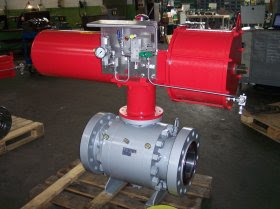Emergency shut down valve (ESD) valves are required to contain and protect sections of a plant in the event of an emergency such as a fire. Standard types of valve intended for ESD service must achieve the highest degree of functional reliability and pressure boundary integrity and may be affected by legislation in some countries. The chief requirement is that the valve can be relied upon to close when asked to do so under any likely conditions of operation. To demonstrate this, periodic tests involving full or partial closure of the valve are required. Tight shut-off is generally a secondary consideration.
The Emergency Shut Down Valve (ESDV, ESD, ESV, SDV) are used to isolate pressure and flow from a particular source during an over pressure situation or detection of a dangerous event. ESD valves are integrated into the design of the plant system equipment and can be installed in-line to any location upstream, midstream or downstream
Emergency Shut Down Valve
Valve types are commonly trunnion mounted ball or slab type gate valves fitted with a fail closed actuator. Slab gate valves can utilize internal pressure and the piston effect of the valve stem to assist closure with consequent reduction in actuator size.
- Trunnion mounted ball or slab type gate valves should be the first choices for dirty service (if the height of the latter can be accommodated and if operating temperatures allow the use of elastomer and polymer seals)
- Floating (seat supported) ball valves should not be used for Emergency shut-down service except if metal seated versions are necessary in high temperature (> 200°C (392°F), low pressure service. In such cases a metal seated, graphite sealed butterfly valve may provide an alternative choice. Operating torque of floating ball valves (particularly metal seated type) is high and can increase markedly if valve condition deteriorates
- Soft seated ball valves may be used in clean service, but if sand, pipe scale, or corrosion product is likely or the valves have to pass pigs, hard coated metal seated valves should be selected. A high degree of seat leak tightness in service is not generally required and, although the “as constructed” leak rate of metal seated valves is usually worse than that of soft seated valves, it is likely to be maintained without significant deterioration in adverse conditions.
- If soft seated valves can be justified, it is advisable to provide protection during line flushing, etc. operations.
- Emergency shut-down ball valves should not normally be fitted with seat sealant injection facilities since this feature is ineffective (and usually unnecessary) in the case of metal seated valves and can never be used post Emergency shut-down in the case of soft seated valves. Such facilities may be useful for solvent flushing of soft seated valves in service where experience has shown this to be beneficial. If drain and vent connections are provided, it may be worth fitting them with valving since this permits the valve cavity to be accessed with the system pressurized should the need arise (e.g. for hot oil flushing to get a jammed seat to move).
- Ball valves having double sealing piston type seats may be used to provide two seals in series. If Emergency shut-down (ESD) valves have a preferred isolation direction it is recommended that only the “downstream” seat should have this feature.
- Balanced, lubricated plug valves may be used if periodic re lubrication can be guaranteed and are particularly suited to gas service applications where maximum compactness is required.
- Sleeved plug valves should not be used for Emergency shut-down applications because of the tendency for operating torque to increase.
- Double or triple offset butterfly valves may also be used in clean gas or liquid service up to Class 600 (PN 100) rating. In high temperature service metal seated, graphite sealed versions may be the best choice.
- Expanding type gate valves and wedge type gate valves should not be used in shut-down service. High operating force requirements at the beginning and end of the operating stroke make these valve types unsuitable for shut down service.
Emergency shut down valve actuators
The actuator and associated control system have a major influence on the performance of Emergency shut-down (ESD) valves and should be chosen with care.
- Emergency shut down valve (ESD) actuators should normally be fail-safe hydraulic type or, for smaller size, low pressure applications in which their greatly increased size can be accommodated, fail-safe pneumatic type.
- Emergency shut down valve (ESD) actuators in hazardous areas should shall be protected against fire and blast to ensure that during a limited fire they can function as required.
i). Protection may be provided by screens, casings, or the application of in tumescent coatings
ii). Access requirements (for maintenance, testing, etc.) should be considered during selection.
- In high temperature service applications it may be necessary to mount actuators on extended spools or yokes or to provide extended valve bonnets to ensure an acceptable operating temperature.
- Emergency shut down valve can be classified into two main types: fail-safe closed and fail-safe open. Fail-safe closed valves are designed to close in the event of an emergency, such as a loss of power or a signal from a safety system. Fail-safe open valves, on the other hand, are designed to open in the event of an emergency, such as a fire or explosion, to release pressure and prevent the buildup of hazardous gases.
Actuator safely factor
Actuators of valves should be capable of applying a torque/force of at least 1.5 times the maximum requirement advised by the manufacturer (and recorded during factory acceptance tests) throughout the open/close cycle.

1 thought on “what is emergency shut down valve”